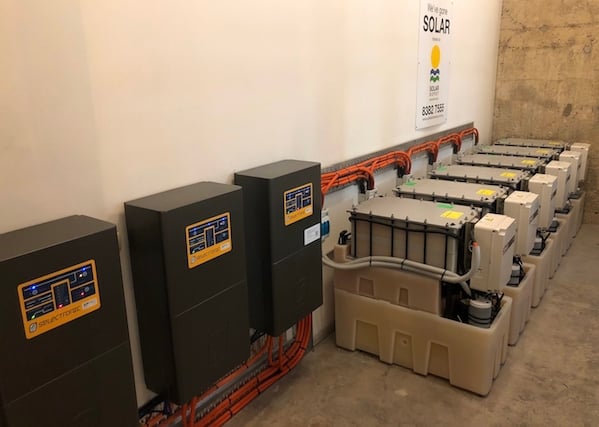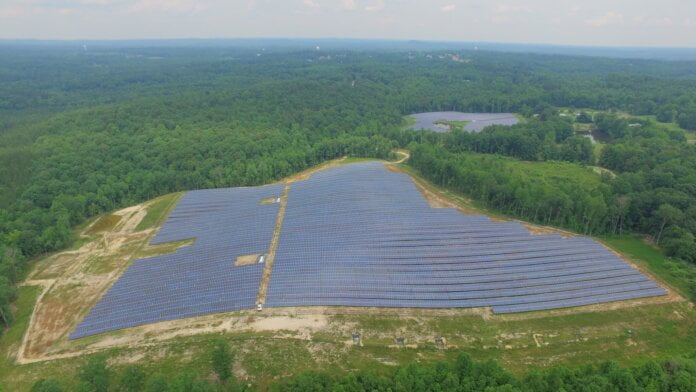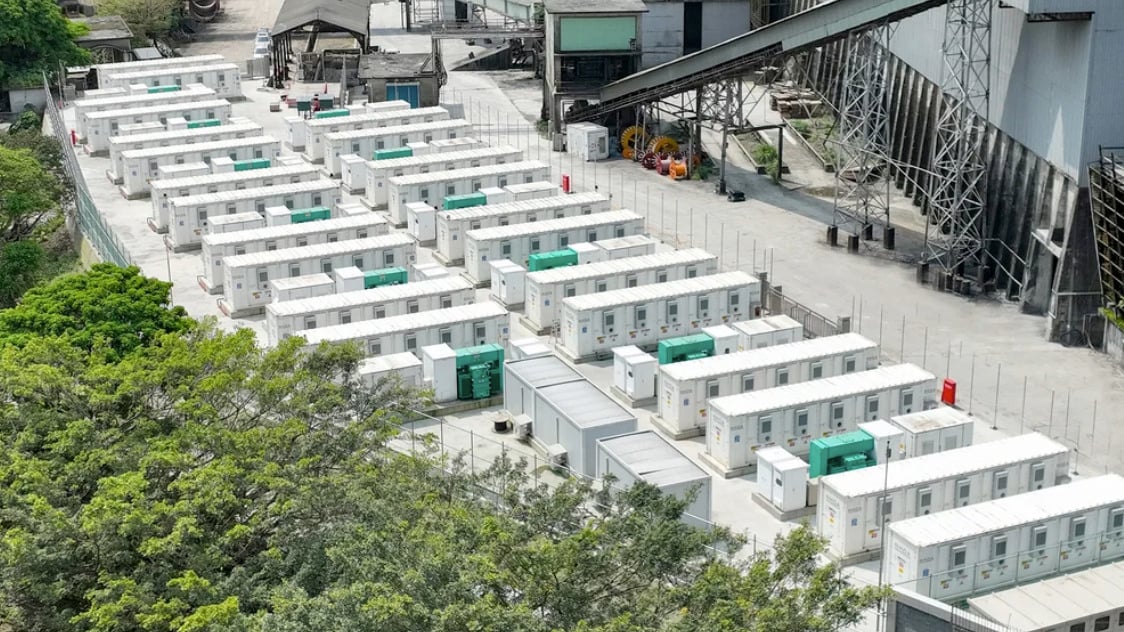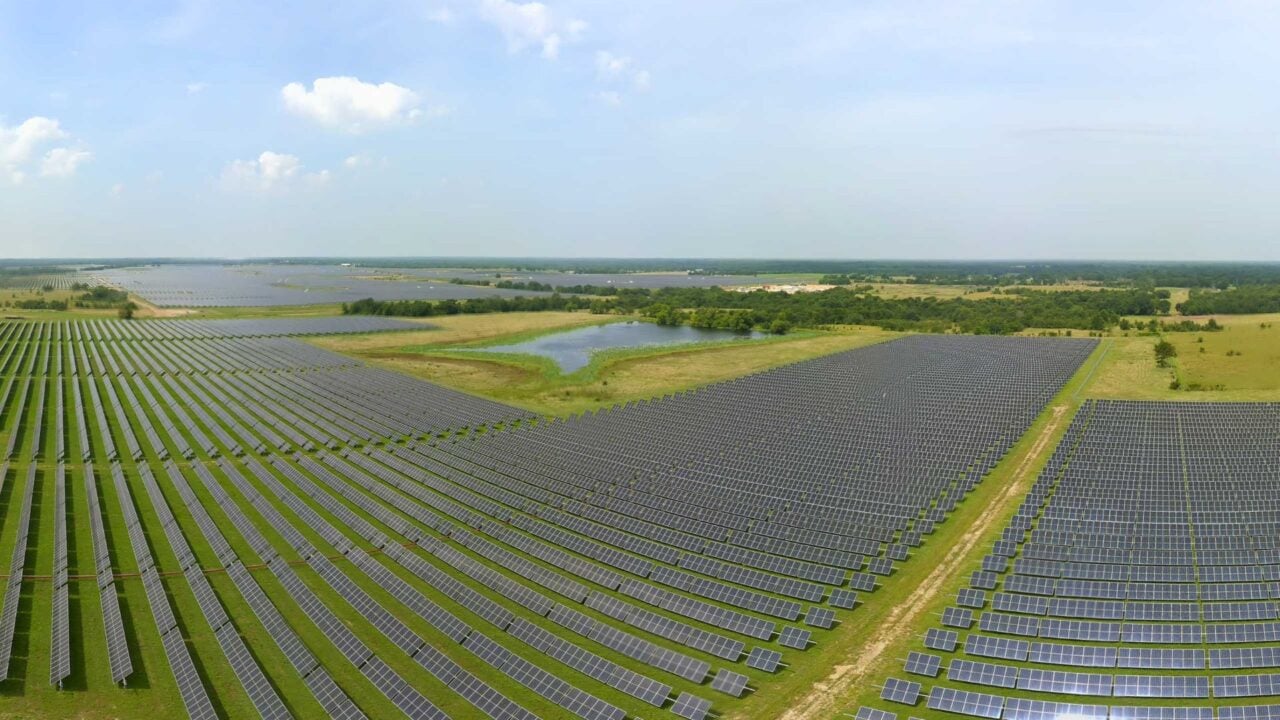It also updated on the asset sale, which was first announced in May. HEIT had scrapped its first quarter dividend and said the fund’s stock was being undervalued by markets, leading to its decision to appoint asset manager JLL to sell some, or all, of its portfolio.
HEIT said the sale process “is progressing” and that prospective bidders have shown “strong” interest. The group claimed indicative non-binding offers are expected to be received within the next month or so.
HEIT’s portfolio includes two of the biggest BESS projects in Europe, Pillswood and Bumpers, equally sized at 98MW/196MWh each. The eight project portfolio totals 395.4MW output to 790MWh capacity (all 2-hour duration assets), of which 79% (312.5MW/625MWh) is operational.
HEIT’s NAV fell slightly (-1.4%) to £215.43 million versus the £218.53 million reported as of the end of April. The latest NAV was equivalent to 94.84p per ordinary share, down by 1.37p per ordinary share since the previous reported period.
A negative mark-to-market valuation of a HEIT interest rate swap impacted the NAV, although the impact was partly offset by the energisation of the group’s 35MW/70MWh Rusholme project in Yorkshire during the period, which has now commenced trading.
Revenues for BESS assets on the grid in Great Britain (GB) have seen a downturn in the past year or so, based largely on market saturation for ancillary services. HEIT’s fellow UK-listed BESS investment funds, Gresham House Energy Storage Fund and Gore Street Capital have both reported challenges over 2024.
At the end of June, in reporting its half-year for the period up to the end of April, HEIT said that “the worst is behind us and better, more profitable times lie ahead,” as it prepared to put three more income-generating assets into action.
However, for the three months ending 31 July, HEIT said lower wholesale market spreads meant revenues were at an average of £45.3k/MW/year, and said decreased wind generation on the GB grid during July in particular impacted BESS revenues across the market.
Low wind was coupled with low gas and carbon prices, reducing average monthly wholesale price spreads to 28% lower for July than June, while the lack of opportunity in the wholesale market drove higher competition for ancillary services, in turn lowering prices for those markets too.
There were some positives looking ahead, HEIT said. The trust welcomed the Labour government’s focus on renewables, as well as National Grid ESO’s recent publication of the Future Energy Scenarios (FES) 2024 document that emphasised the need for continued BESS buildout to support the electricity system.
While low wind production meant lower spreads and therefore lower revenues in July, August is already seeing higher levels of solar PV and wind on the grid, which HEIT said correlated with a marked improvement in revenues. It estimated that month-to-date revenues for August averaged £67.2k/MW/year in its portfolio.
To read the full version of this story, visit Solar Power Portal.
UK BESS investor Harmony Energy Income Trust ‘close to receiving offers’ in portfolio sale
It also updated on the asset sale, which was first announced in May. HEIT had scrapped its first quarter dividend and said the fund’s stock was being undervalued by markets, leading to its decision to appoint asset manager JLL to sell some, or all, of its portfolio.
HEIT said the sale process “is progressing” and that prospective bidders have shown “strong” interest. The group claimed indicative non-binding offers are expected to be received within the next month or so.
HEIT’s portfolio includes two of the biggest BESS projects in Europe, Pillswood and Bumpers, equally sized at 98MW/196MWh each. The eight project portfolio totals 395.4MW output to 790MWh capacity (all 2-hour duration assets), of which 79% (312.5MW/625MWh) is operational.
HEIT’s NAV fell slightly (-1.4%) to £215.43 million versus the £218.53 million reported as of the end of April. The latest NAV was equivalent to 94.84p per ordinary share, down by 1.37p per ordinary share since the previous reported period.
A negative mark-to-market valuation of a HEIT interest rate swap impacted the NAV, although the impact was partly offset by the energisation of the group’s 35MW/70MWh Rusholme project in Yorkshire during the period, which has now commenced trading.
Revenues for BESS assets on the grid in Great Britain (GB) have seen a downturn in the past year or so, based largely on market saturation for ancillary services. HEIT’s fellow UK-listed BESS investment funds, Gresham House Energy Storage Fund and Gore Street Capital have both reported challenges over 2024.
At the end of June, in reporting its half-year for the period up to the end of April, HEIT said that “the worst is behind us and better, more profitable times lie ahead,” as it prepared to put three more income-generating assets into action.
However, for the three months ending 31 July, HEIT said lower wholesale market spreads meant revenues were at an average of £45.3k/MW/year, and said decreased wind generation on the GB grid during July in particular impacted BESS revenues across the market.
Low wind was coupled with low gas and carbon prices, reducing average monthly wholesale price spreads to 28% lower for July than June, while the lack of opportunity in the wholesale market drove higher competition for ancillary services, in turn lowering prices for those markets too.
There were some positives looking ahead, HEIT said. The trust welcomed the Labour government’s focus on renewables, as well as National Grid ESO’s recent publication of the Future Energy Scenarios (FES) 2024 document that emphasised the need for continued BESS buildout to support the electricity system.
While low wind production meant lower spreads and therefore lower revenues in July, August is already seeing higher levels of solar PV and wind on the grid, which HEIT said correlated with a marked improvement in revenues. It estimated that month-to-date revenues for August averaged £67.2k/MW/year in its portfolio.
To read the full version of this story, visit Solar Power Portal.
UK BESS investor Harmony Energy Income Trust ‘close to receiving offers’ in portfolio sale
It also updated on the asset sale, which was first announced in May. HEIT had scrapped its first quarter dividend and said the fund’s stock was being undervalued by markets, leading to its decision to appoint asset manager JLL to sell some, or all, of its portfolio.
HEIT said the sale process “is progressing” and that prospective bidders have shown “strong” interest. The group claimed indicative non-binding offers are expected to be received within the next month or so.
HEIT’s portfolio includes two of the biggest BESS projects in Europe, Pillswood and Bumpers, equally sized at 98MW/196MWh each. The eight project portfolio totals 395.4MW output to 790MWh capacity (all 2-hour duration assets), of which 79% (312.5MW/625MWh) is operational.
HEIT’s NAV fell slightly (-1.4%) to £215.43 million versus the £218.53 million reported as of the end of April. The latest NAV was equivalent to 94.84p per ordinary share, down by 1.37p per ordinary share since the previous reported period.
A negative mark-to-market valuation of a HEIT interest rate swap impacted the NAV, although the impact was partly offset by the energisation of the group’s 35MW/70MWh Rusholme project in Yorkshire during the period, which has now commenced trading.
Revenues for BESS assets on the grid in Great Britain (GB) have seen a downturn in the past year or so, based largely on market saturation for ancillary services. HEIT’s fellow UK-listed BESS investment funds, Gresham House Energy Storage Fund and Gore Street Capital have both reported challenges over 2024.
At the end of June, in reporting its half-year for the period up to the end of April, HEIT said that “the worst is behind us and better, more profitable times lie ahead,” as it prepared to put three more income-generating assets into action.
However, for the three months ending 31 July, HEIT said lower wholesale market spreads meant revenues were at an average of £45.3k/MW/year, and said decreased wind generation on the GB grid during July in particular impacted BESS revenues across the market.
Low wind was coupled with low gas and carbon prices, reducing average monthly wholesale price spreads to 28% lower for July than June, while the lack of opportunity in the wholesale market drove higher competition for ancillary services, in turn lowering prices for those markets too.
There were some positives looking ahead, HEIT said. The trust welcomed the Labour government’s focus on renewables, as well as National Grid ESO’s recent publication of the Future Energy Scenarios (FES) 2024 document that emphasised the need for continued BESS buildout to support the electricity system.
While low wind production meant lower spreads and therefore lower revenues in July, August is already seeing higher levels of solar PV and wind on the grid, which HEIT said correlated with a marked improvement in revenues. It estimated that month-to-date revenues for August averaged £67.2k/MW/year in its portfolio.
To read the full version of this story, visit Solar Power Portal.
UK BESS investor Harmony Energy Income Trust ‘close to receiving offers’ in portfolio sale
It also updated on the asset sale, which was first announced in May. HEIT had scrapped its first quarter dividend and said the fund’s stock was being undervalued by markets, leading to its decision to appoint asset manager JLL to sell some, or all, of its portfolio.
HEIT said the sale process “is progressing” and that prospective bidders have shown “strong” interest. The group claimed indicative non-binding offers are expected to be received within the next month or so.
HEIT’s portfolio includes two of the biggest BESS projects in Europe, Pillswood and Bumpers, equally sized at 98MW/196MWh each. The eight project portfolio totals 395.4MW output to 790MWh capacity (all 2-hour duration assets), of which 79% (312.5MW/625MWh) is operational.
HEIT’s NAV fell slightly (-1.4%) to £215.43 million versus the £218.53 million reported as of the end of April. The latest NAV was equivalent to 94.84p per ordinary share, down by 1.37p per ordinary share since the previous reported period.
A negative mark-to-market valuation of a HEIT interest rate swap impacted the NAV, although the impact was partly offset by the energisation of the group’s 35MW/70MWh Rusholme project in Yorkshire during the period, which has now commenced trading.
Revenues for BESS assets on the grid in Great Britain (GB) have seen a downturn in the past year or so, based largely on market saturation for ancillary services. HEIT’s fellow UK-listed BESS investment funds, Gresham House Energy Storage Fund and Gore Street Capital have both reported challenges over 2024.
At the end of June, in reporting its half-year for the period up to the end of April, HEIT said that “the worst is behind us and better, more profitable times lie ahead,” as it prepared to put three more income-generating assets into action.
However, for the three months ending 31 July, HEIT said lower wholesale market spreads meant revenues were at an average of £45.3k/MW/year, and said decreased wind generation on the GB grid during July in particular impacted BESS revenues across the market.
Low wind was coupled with low gas and carbon prices, reducing average monthly wholesale price spreads to 28% lower for July than June, while the lack of opportunity in the wholesale market drove higher competition for ancillary services, in turn lowering prices for those markets too.
There were some positives looking ahead, HEIT said. The trust welcomed the Labour government’s focus on renewables, as well as National Grid ESO’s recent publication of the Future Energy Scenarios (FES) 2024 document that emphasised the need for continued BESS buildout to support the electricity system.
While low wind production meant lower spreads and therefore lower revenues in July, August is already seeing higher levels of solar PV and wind on the grid, which HEIT said correlated with a marked improvement in revenues. It estimated that month-to-date revenues for August averaged £67.2k/MW/year in its portfolio.
To read the full version of this story, visit Solar Power Portal.
UK BESS investor Harmony Energy Income Trust ‘close to receiving offers’ in portfolio sale
It also updated on the asset sale, which was first announced in May. HEIT had scrapped its first quarter dividend and said the fund’s stock was being undervalued by markets, leading to its decision to appoint asset manager JLL to sell some, or all, of its portfolio.
HEIT said the sale process “is progressing” and that prospective bidders have shown “strong” interest. The group claimed indicative non-binding offers are expected to be received within the next month or so.
HEIT’s portfolio includes two of the biggest BESS projects in Europe, Pillswood and Bumpers, equally sized at 98MW/196MWh each. The eight project portfolio totals 395.4MW output to 790MWh capacity (all 2-hour duration assets), of which 79% (312.5MW/625MWh) is operational.
HEIT’s NAV fell slightly (-1.4%) to £215.43 million versus the £218.53 million reported as of the end of April. The latest NAV was equivalent to 94.84p per ordinary share, down by 1.37p per ordinary share since the previous reported period.
A negative mark-to-market valuation of a HEIT interest rate swap impacted the NAV, although the impact was partly offset by the energisation of the group’s 35MW/70MWh Rusholme project in Yorkshire during the period, which has now commenced trading.
Revenues for BESS assets on the grid in Great Britain (GB) have seen a downturn in the past year or so, based largely on market saturation for ancillary services. HEIT’s fellow UK-listed BESS investment funds, Gresham House Energy Storage Fund and Gore Street Capital have both reported challenges over 2024.
At the end of June, in reporting its half-year for the period up to the end of April, HEIT said that “the worst is behind us and better, more profitable times lie ahead,” as it prepared to put three more income-generating assets into action.
However, for the three months ending 31 July, HEIT said lower wholesale market spreads meant revenues were at an average of £45.3k/MW/year, and said decreased wind generation on the GB grid during July in particular impacted BESS revenues across the market.
Low wind was coupled with low gas and carbon prices, reducing average monthly wholesale price spreads to 28% lower for July than June, while the lack of opportunity in the wholesale market drove higher competition for ancillary services, in turn lowering prices for those markets too.
There were some positives looking ahead, HEIT said. The trust welcomed the Labour government’s focus on renewables, as well as National Grid ESO’s recent publication of the Future Energy Scenarios (FES) 2024 document that emphasised the need for continued BESS buildout to support the electricity system.
While low wind production meant lower spreads and therefore lower revenues in July, August is already seeing higher levels of solar PV and wind on the grid, which HEIT said correlated with a marked improvement in revenues. It estimated that month-to-date revenues for August averaged £67.2k/MW/year in its portfolio.
To read the full version of this story, visit Solar Power Portal.
Zinc-bromine flow battery maker Redflow ‘unable to continue as going concern’
However, those commitments required Redflow to match the government funding on offer, and attempts to raise equity support did not bear fruit, Redflow said last week (23 August).
“In the absence of such support, the Directors believe that Redflow is unable to continue as a going concern and have no option but to place the Redflow Group into voluntary administration,” a statement made to the Australian Securities Exchange (ASX) read.
Redflow headquartered in Brisbane, manufactures a proprietary hybrid flow battery technology based on zinc-bromine liquid electrolyte and zinc plating. This technology is aimed at long-duration energy storage (LDES) applications and has largely been used in off-grid and commercial and industrial (C&I) installations both in Redflow’s home country and overseas.
The company’s CEO Tim Harris told Energy-Storage.news Premium in 2023 that, rather than the more commonly used vanadium pentoxide electrolyte or novel organic compounds, zinc-bromine offers higher energy and power density, while also being abundant and easier to source raw materials.
It also has the advantage of being transportable with liquid electrolyte already inside the tanks, a feature that lowered the cost and complexity of onsite integration, Harris said. Its higher energy density meant a smaller footprint and lower balance of system costs, the CEO claimed.
From its base in Australia, Redflow had also gone international with a factory in Thailand opened in 2017, and overseas projects that included a completed 2MWh C&I project in California, and another 20MWh in the same US state which got its notice-to-proceed (NTP) six months ago. One of its microgrid projects in the US was among a number of LDES demonstration and pilots picked out for financial support from the US Department of Energy (DOE) in a competitive award scheme last year.
With Queensland’s government looking to strongly support both deployment and manufacturing of battery technologies through state policies, including vanadium and non-vanadium flow batteries, Redflow had looked poised to benefit.
However, it seems that even this backing hasn’t been enough to convince investors in the current market climate despite “significant commercial interest” in its proposed new Redflow X10 flow battery tech.
Directors at Redflow and its subsidiaries have appointed consultants from Deloitte as Voluntary Administrators. They will review and assess the company’s business and financial position before making recommendations on its future. Trading in shares will be suspended as the process continues.
Arevon Starts Construction on 192 MW Indiana Solar Project
Arevon’s North Carolina Haywood Solar Project
Arevon Energy has celebrated the start of construction on the company’s 192 MW Ratts 1 Solar Project, located in Pike County, Ind.
In addition to the Ratts 1 project, the company developed and has started construction on the nearby 73 MW Heirloom Solar Project.
Local leaders; landowners; partners and stakeholders; the project’s construction contractor, Primoris Renewable Energy; and the Arevon project team attended the groundbreaking ceremony.
“Ratts 1 Solar is a significant addition to Arevon’s growing portfolio of Midwest projects and an important step forward for a cleaner future for Indiana,” says Tommy Greer, chief commercial officer at Arevon.
“We are proud to host this groundbreaking and to celebrate the advancement of solar energy in Pike County.”
In addition to Ratts 1 Solar and Heirloom Solar, the company announced a $352 million financing package to build the 228 MW Posey Solar Project in Indiana, with construction underway.
Continue readingCleanCapital Forms Development Partnership with Arena Renewables
Julia Bell
CleanCapital has established a development partnership with Arena Renewables, with the companies set on bringing grid-critical assets to markets that include Illinois and Maryland.
Under the terms of the agreement, the companies will work together to finance and develop a portfolio of distributed solar projects focusing on community solar and corporate offtake. Arena Renewables will develop the projects, with CleanCapital providing a mix of debt and equity instruments to support Arena Renewables’ growth and operations, as well as own and operate projects long-term.
“We are excited to enter into this partnership with Arena Renewables because, at the core, they are dedicated to bringing more clean energy megawatts onto the grid to serve communities in need,” says Julia Bell, CIO at CleanCapital.
“The Arena team brings over three decades of experience in renewables, utilities and real estate along with their credibility and execution of solar and storage projects.”
CleanCapital’s pipeline totals 2 GW of solar and 8 GWh of energy storage.
Orrick, Herrington & Sutcliffe acted as counsel for CleanCapital on the transaction.
Continue readingTCC ups valuation of NHOA shares ahead of takeover
The move would take NHOA fully into private ownership and result in its delisting from the Euronext Paris Exchange. In an interview with Energy-Storage.news Premium published in July, Giuseppe Artizzu, head of NHOA’s energy storage business line, said the move would be a “financial efficiency driver.”
However, an ad hoc committee of NHOA’s Board of Directors said earlier this week (19 August) that it had some reservations about the fairness of the parent company’s offer to purchase shares at €1.10 (US$1.22) per share.
Based on preliminary analysis by an independent expert and its financial advisor, the board suggested that the value should be higher due to the potential of two of NHOA’s e-mobility infrastructure businesses, including a joint venture with automotive OEM Stellantis and a fast and ultra-fast EV charging division.
TCC responded by increasing the price to €1.25 per NHOA share after its Board of Directors met on 20 August. TCC said the new price represented a 114% premium over the closing share price (€0.58) on 12 June, the day before the takeover was announced, prompting a jump to €1.06 at closing on 13 June.
TCC’s board also said the new price reflects significant premiums over volume-weighted average prices up to 180 days before the tender offer announcement.
Negotiations will resume between the two parties on that basis. NHOA shares remain suspended from trading in the meantime, with an updated draft offer document to be filed with the French regulator, AMF, by mid-September 2024, meaning the tender offer and subsequent squeeze-out process will continue longer than originally planned.
NHOA Energy, the company’s battery energy storage system (BESS) business line, reported an 11% year-on-year fall in revenues for the first half of 2024. Releasing its half-year results in July, the system integrator attributed this to a market-wide fall in the price of BESS.
NHOA Energy clocked €90 million in revenues for H1 2024, while EV charging solutions arm Atlante’s rose 7% to €124 million, and its JV with Stellantis, Free2Move, doubled its revenue year-on-year to €32 million.
Despite the drop, NHOA Energy was EBITDA positive for the period by €4.4 million, and BESS projects deployed and in operation rose 344% from H1 2023 to more than 1GWh, while it cited a further gigawatt-hour currently being in construction.
In the ESN Premium interview, NHOA Energy CEO Artizzu said the listing of the company’s shares was by that point “almost counterproductive” with low volumes of trading, and that after the squeeze out the integrator would be better able to leverage TCC’s balance sheet to go for big gigawatt-hour scale projects. Despite its impending removal from the stock exchange, it would remain in NHOA’s best interests to maintain a degree of “financial visibility,” the CEO said.
“If we want to be a bankable provider, we need to give visibility, so it is going to be in my interest to ensure that enough visibility is given to the market on our financial reports.”
Enel starts operations at solar-plus-storage plant in Texas, BESS nearly commissioned
The project is equipped with Sungrow SG3600UD-MV solar PV inverters, with each unit of 3.35MW, with 78 units enabling the metered output of 255MW of power, according to a Filing Receipt logged with the regulatory Public Utility Commission (PUC) of Texas. The document notes that the project is eligible for Renewable Energy Credits (RECs) for the 255MW net eligible generation.
Food and beverage giant Nestlé is the sole tax equity investor of the project and will also acquire the renewable energy generated from the solar PV plant, in which Enel owns 100% of the equity.
This is not the first time both companies have partnered for a solar-plus-storage project in Texas. Last year, Enel NA and Nestlé partnered on the Ganado project, in Jackson County, with both an investment and 15-year power purchase agreement (PPA).
Stephen Pike, head of Enel North America’s renewable energy business, Enel Green Power North America, said: “The Stampede project will add more power generation to the grid at a time when demand is rising from electrification and data centers. Furthermore, its flexible battery storage system will help step in to stabilize the grid when conditions tighten.”
Enel’s interest in ERCOT market
This is the latest solar-plus-storage project in Texas powered by Enel. Earlier this year, the company started operations at the Fence Post project in Navarro County, as covered by our sister-site PV Tech. Similar to the Stampede project, it has an 86MW BESS installed along with 297MW of solar PV capacity.
On top of its latest solar-plus-storage projects in Texas, Enel brought five BESS projects online in ERCOT last year. The five projects combined for 369MW/555MWh of energy storage. In the past few years, Enel has been increasing its operational capacity for BESS projects, and setting itself as the largest BESS owner-operator in the the ERCOT, Texas market.
Energy-storage.news recently spoke with its CEO, Paolo Romanacci, about the status of the ERCOT market and more overall the BESS industry in the US. Romanacci highlighted the need for an increased domestic manufacturing industry (Premium access).
With nearly 5GW of large-scale BESS online in ERCOT, Texas is one of the leading markets for BESS in the US. In a recent conversation with Modo Energy (Premium access), one of the trends in the ERCOT market is that revenues are becoming more concentrated in a small number of days.







